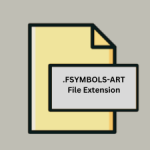.MIC File Extension

Image Composer File
| Developer | Microsoft |
| Popularity | |
| Category | Raster Image Files |
| Format | .MIC |
| Cross Platform | Update Soon |
What is an MIC file?
The .MIC file extension is associated with Microsoft Image Composer, a graphics editor developed by Microsoft. These files typically contain image data, including various elements like shapes, text, and layers, used for creating and editing images.
More Information.
Microsoft Image Composer was first introduced in 1996. The software was designed to provide an easy-to-use tool for creating web graphics, allowing users to create and edit images with layers, transparency, and various effects. The .MIC file format was used to save the projects created with this software, preserving all the elements and layers for further editing.
Origin Of This File.
The .MIC file format was created by Microsoft for use with their Image Composer software. Microsoft Image Composer was included as part of Microsoft FrontPage, a web development tool, in the late 1990s.
File Structure Technical Specification.
The .MIC file format is proprietary to Microsoft and designed specifically for use with Image Composer.
It stores image data in a structured format, including:
- Layers: Each layer can contain different elements such as shapes, text, and images.
- Transparency: Allows for the creation of images with transparent backgrounds or elements.
- Effects: Various effects can be applied to layers, such as shadows, gradients, and color adjustments.
- Vector and Raster Data: Can include both vector graphics and raster images within the same file.
How to Convert the File?
Windows
- Using Microsoft Image Composer:
- Open the .MIC file: Launch Microsoft Image Composer and open the .MIC file.
- Save or Export: Use the “Save As” or “Export” option to save the file in a different format, such as .PNG, .JPEG, or .BMP.
- Using File Conversion Software:
- File Viewer Plus: Some file viewer applications like File Viewer Plus might support .MIC files and provide options to convert them to other formats.
- Online Converters: Check online conversion services (e.g., Zamzar, Convertio) that might support .MIC files.
Linux
- Using Wine:
- Install Wine: Use your package manager to install Wine (
sudo apt-get install wineon Debian-based systems). - Install Microsoft Image Composer: Use Wine to install Microsoft Image Composer.
- Open and Convert: Open the .MIC file in Image Composer and use the save/export options to convert it.
- Install Wine: Use your package manager to install Wine (
- Using Online Converters:
- Upload and Convert: Use online conversion services (e.g., Zamzar, Convertio) to upload the .MIC file and convert it to a different format.
Mac
- Using Wine or CrossOver:
- Install Wine or CrossOver: Download and install Wine or CrossOver on your Mac.
- Install Microsoft Image Composer: Use Wine or CrossOver to install Microsoft Image Composer.
- Open and Convert: Open the .MIC file in Image Composer and convert it using the save/export options.
- Using Online Converters:
- Upload and Convert: Use an online converter service to upload the .MIC file and convert it to another format.
Android
- Remote Desktop:
- Connect to a Windows PC: Use a remote desktop application to connect to a Windows PC that has Microsoft Image Composer installed.
- Convert the File: Open and convert the .MIC file on the remote PC.
- Online Converters:
- Upload and Convert: Use an Android web browser to access online conversion services and upload the .MIC file for conversion.
iOS
- Remote Desktop:
- Connect to a Windows PC: Use a remote desktop app (like Microsoft Remote Desktop) to connect to a Windows PC with Microsoft Image Composer installed.
- Convert the File: Open and convert the .MIC file on the remote PC.
- Online Converters:
- Upload and Convert: Use Safari or another web browser to access online converters and upload the .MIC file for conversion.
Others
- Virtual Machines:
- Set Up a VM: Set up a virtual machine with a Windows OS.
- Install Microsoft Image Composer: Install Microsoft Image Composer on the virtual machine.
- Open and Convert: Open the .MIC file in the virtual machine and use the save/export options to convert it.
- Online Converters:
- Upload and Convert: Use online conversion services on any device with a web browser to convert the .MIC file.
Advantages And Disadvantages.
Advantages:
- Layer Support: Allows complex image compositions with multiple editable layers.
- Transparency and Effects: Supports advanced features like transparency and effects, enhancing the creative possibilities.
- Integration with FrontPage: Seamlessly integrated with Microsoft FrontPage for web development.
Disadvantages:
- Proprietary Format: Limited compatibility with other software due to its proprietary nature.
- Discontinued Software: Microsoft Image Composer is no longer supported or updated, making it harder to use on modern systems.
- Limited Documentation: Due to its proprietary nature and discontinuation, there is limited documentation and community support.
How to Open MIC?
Open In Windows
- Microsoft Image Composer: If you have access to the software, you can open .MIC files directly.
- File Viewer Plus: Some file viewer applications might support opening .MIC files.
Open In Linux
Wine: You can try running Microsoft Image Composer using Wine, a compatibility layer for running Windows applications on Linux.
Open In MAC
Wine or CrossOver: Similar to Linux, you can use Wine or CrossOver to run Microsoft Image Composer on a Mac system.
Open In Android
Not Directly Supported: There is no native support for .MIC files on Android. You may need to convert the file on a computer first.
Open In IOS
Not Directly Supported: Similar to Android, .MIC files are not natively supported on iOS devices. Conversion on a computer is necessary.
Open in Others
Virtual Machines or Emulators: You can use virtual machines running Windows with Microsoft Image Composer installed to open .MIC files.













